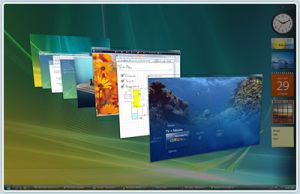I’ve owned and continuously operated Microsoft PCs since that clunky 8086 behemoth running MS-DOS 3.3 that I took to college with me in 1989. It ran at a sizzling 6 MHz, unless you pressed the big white button labeled “Turbo” on the front, and then — look out! — 12 MHz. (Why you would ever turn this button off, I don’t know.)
In all that time, I’ve never been hit by a computer virus, worm, or malicious piece of spyware. Once, not too long ago, I actually double-clicked on a virus-infected e-mail attachment without thinking, but my computer security package quickly caught it and disabled it.
That’s not to say that I’ve never received a virus over e-mail, or suffered an attack on my firewall. These things happen all the time. I’ve been to web pages that could conceivably have launched various bits of nastiness onto my machine had I not been running Firefox with a pop-up blocker and lots of Javascript restrictions. I’ve just never suffered the effects.
 And why have I never suffered from a virus outbreak? Because, despite what you see and hear all over the Internet and the media, the security problems of Windows are vastly overblown. Windows is and has always been a fairly secure operating system, if you know what you’re doing.
And why have I never suffered from a virus outbreak? Because, despite what you see and hear all over the Internet and the media, the security problems of Windows are vastly overblown. Windows is and has always been a fairly secure operating system, if you know what you’re doing.
True, I’m what they call a computer professional, meaning that I make my living on these things. I can program PHP and ColdFusion. But when it comes to the operating system, I’m not some technical uber-wizard that can pinpoint obscure DLL failures using the command line. I know how to edit the Windows Registry, I know how to start and stop Windows Services, I know how to use the Event Viewer. These are all fairly basic computer troubleshooting skills, and yet these skills and some readily available off-the-shelf security software are all it’s taken for me to keep my computer safe for nearly 20 years.
(And no, this is not an invitation for someone out there to try and craft something that will infest my computer. I’m sure you can. But the point is that you haven’t bothered to try yet.)
The security problem, therefore, does not lie with Windows software. The problem is with Windows usability.
Most of you reading this blog may be astounded to realize this, but Microsoft’s most pressing problem is not the encroachment of free and open source Linux. It’s not the growing popularity of the Firefox browser, or the lagging performance of its online properties in relation to Google’s and Yahoo’s, or the activities of a small population of malicious hackers and crackers. The thing that keeps the Microsoft brass up at night, believe it or not, is that most people feel like Windows is too darned hard to use.
To us in the tech world, it seems like every Joe and Jane you pass in the street reads Slashdot and has contemplated switching to Ubuntu. But the vast majority of people aren’t nearly that technically savvy. I found a study from 1997 that gives the number of IT jobs in the United States at 2,063,000. Even if we’re charitable and say that, despite the IT bubble burst, the number of tech jobs has doubled since then — or even tripled — we’re still only talking about roughly 2% of the U.S. population. We’re a lot more computer-literate than we were a decade ago, but I’m willing to bet at least 70% of the Windows users in the United States have never even heard of the Registry.